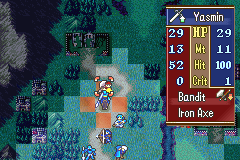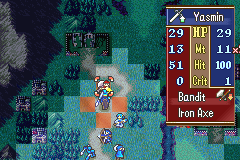While Steel weapons are often called quite poor in vanilla GBA Fire Emblem, the design goals underlying them are quite important. To understand why, it’s important to first understand the concept of nRKO standards, and how various weapons impact them.
-Terms and Stuff-
An nRKO (n-round KO) standard is basically just a vague, somewhat reductive way to describe how effectively you expect the player to be dealing with enemies. A 3RKO standard would indicate that player units tend to deal with enemy units in 3 combat interactions (rounds) when using basic weaponry. Again, I’d like to emphasize that a 3RKO standard doesn’t mean every player unit should 3RKO every enemy with Iron, nor does it mean that this is even feasible. It’s a generalization, and it’s usually a good idea for units to have noticeably good/bad matchups.
Tempo is similar. For the sake of this design post, tempo is my way of describing how effective and meaningful each player unit’s action is. If you’re dealing with a lot of enemies and side objectives in a low number of turns, that’s higher tempo. Walking around a map after having essentially already completed the objective would be considered low tempo, because you’re pretty much already done. The higher a map’s tempo is, the more exciting and engaging it can be, but at the same time, higher tempo places greater mental strain on the player, and it can feel exceedingly punishing when things happen too fast.
Tempo isn’t solely dependent on how fast player/enemy units die. However, it is a factor, and there are a wealth of reasons why you may not want units on either side to die too quickly or too slowly, with tempo being the one I find to be most broadly useful. As such, systems that let the designer more tightly manage tempo are an innately powerful design tool. Strong, heavy Steel weapons are a useful design tool because they let the designer choose which enemies they want to die faster.
-Okay, Cool, but Now What-
As a general rule of thumb:
- Iron weapons on enemies maintain tempo. They don’t really help or hurt. Your nRKO threshold is literally defined by combat with basic tools, and these are as basic as they get.
- Steel weapons on enemies accelerate tempo. Basically: Steel enemies die faster but also kill you faster. This also applies to weapons with the same type of statline, like blades and Elfire.
When this fighter uses a Steel Axe instead of an Iron Axe, my Iron Sword cavalier now kills him in 2 combat interactions instead of 3, but faces a 2HKO on the counter, as opposed to the previous 3HKO.
*For reference, this Fighter is losing 2 AS from his 14 Wt Steel Axe.
Of course, some units will double unpenalized enemies, and that’s fine too. Units like that can utilize heavy weapons against Steel enemies to secure kills they’d otherwise miss.
In this example, my cavalier has +1 Spd, allowing her to double the fighter regardless of his weapon. However, the Steel enemy is still easier to kill, as she can use the somewhat heavy Iron Blade to 2HKO.
*For reference, the Steel Axe and Iron Blade weigh their respective users down by 2.
This doesn’t mean you shouldn’t be willing to tweak stats of vanilla steel weapons, of course. They’re on the whole way too inaccurate to consistently threaten their higher damage, and Steel Lance/Axe in particular are probably a point or so too heavy in a vanilla context. Just make sure to consider your hack’s context, not vanilla FE7’s.
-So Why Is This Different From Normal Speed Tiers-
In a word, weapon variety (okay, two words.) Weapon variety is integral to keeping enemies unique and dangerous through the lategame, but you can’t just stick to linear weapon upgrades for the first half of the game before switching to varied threats towards the end. If you haven’t taught the player to watch out for dangerous stuff, they won’t be looking for it. Giving early and midgame enemies both Irons and Steels introduces basic weapon variety out the gate, and rewards the player for paying attention to what the enemy has equipped (this is where the high Weight comes into play again.) With this, it won’t feel unfair when you give enemies weapons like Reavers and effectives, as the player is used to thinking about the enemy’s weapons already.
-Miscellany-
Less universally true, but still useful to know:
- Defensive weapons decrease tempo. Shackled Power’s Slim weapons give +3 Spd, making the enemy harder to double, while doing less damage. Useful for “annoying” enemies, or guys who exist to ping you so other, scarier enemies kill you more easily. Sometimes it’s good to not threaten the player.
- Physical 1-2 range weapons (or weapons with extended range as a whole) tend to allow enemies to safely avoid counterattacks, while again doing less damage. They’re still usually pretty heavy, though, so player phasing is rewarded with more damage.
- Weapons that lower Def/Res while equipped, or otherwise directly increase damage taken, are similar to Steels in their impact on tempo. They’re still worth consideration, of course, as enemies with these enemies tend to be easier to OHKO outright, and you can put a lot of messed up effects on these types of weapons without it feeling unfair or unfun.
- Siege is… complicated. I think that well placed siege should generally force the player to deal with the siege threat(s) aggressively, which forces the player to move faster and increases tempo. However, a lot of poorly handled siege does the inverse, incentivizing the player to slowly waste enemy bolting charges (and consequently, their own time.) That’s not to say that siege that can’t/shouldn’t easily be killed is always bad, or that siege you have to move aggressively to deal with is always good. Like I said, complicated, and probably best left for another day.



